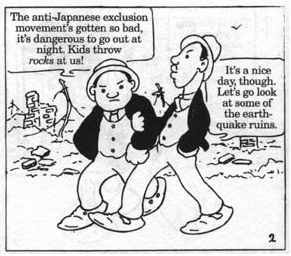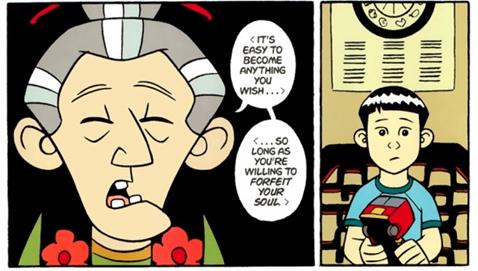|
|
LITR
5831 World / Multicultural Literature: |
|
Hanna
Mak
6
July 2016
Graphic Novels and Immigrant Experience
“How does the medium of the comic strip or graphic novel impact the ways
in which an immigrant’s story is told? How does the narrative vary in relation
to the generation of the storyteller?” I asked, somewhat naively. As it turns
out, the former is not a question that can be answered with brevity, and the
latter question is basically irrelevant within this genre. Almost all of the
comics and graphic novels that I encountered in my research were penned by at
least second generation Americans, and furthermore, their narrative variances
appeared to have been more substantially governed by the developing trends
within the medium itself, in addition to prevailing cultural attitudes of each
era. In hindsight, it seems almost too obvious—who is more likely to author a
graphic novel? Old-fashioned
parents, uncles, and aunties who are busy establishing themselves in a new
country, or their Americanized children? The evolution of the “immigrant comic”
genre is firmly rooted within developments of mainstream American pop culture,
and ultimately caters to the multifaceted desires of its variable audience.
While overall, it tends to speak empathetically to the experiences of the first
generation, its impulses are more often deeply rooted in the “divided” nature of
the second generation, who find themselves toeing the line between tradition and
modernity. Each of these comics attempts to somehow make sense of their
respective authors’ nebulous identities as second-generation Americans, but they
do so in radically different ways, and to equally varied effects.
A unique question that many critics of the immigrant comic genre seem to
continually raise (to varying degrees) is one of “authenticity.” Are the mimetic
qualities of either traditional written immigrant narratives or other graphic
novel genres subjected to equal scrutiny? Could the genre’s place within pop
culture account for this level of analysis and implied skepticism? In his
studies of the graphic novel, critic Stephen E. Tabachnick continually measures
representations of Jewish-American experience with this yardstick of
“authenticity,” appearing to draw upon memories from his own life in order to
lend his personal credence to the graphic novels he studies. In his analysis of
Martin Lemelman’s Two Cents Plain and
Mendel’s Daughter, he cites the
“heavy use of Yiddish” in the character’s speech, as well as a nostalgic list of
familiar cultural artifacts from the 1940s and 50s, that apparently contribute
to his sense of “seeing and hearing a true story” (129, 131).

(Above: Example of visual style from the graphic memoir,
Two Cents Plain)
It is
clear that Tabachnick values the narratives of these novels due to their
relationship to his own identity and desire for nostalgia: “As a Jew of
Lemelman’s generation . . . I feel that these could be
my relatives” (132). Beyond measuring
the authenticity of Lemelman’s experience against his own, he offers little
in-depth analysis of the pieces’ content. He affirms Lemelman’s nostalgic truth
as accordant with his own—a fact that is uninteresting in itself. What is far
more interesting, perhaps, is the simple fact that he
believes this insider’s affirmation
is sufficient to recommend the novel to others. This firm belief reflects this
particular graphic narrative’s purpose; the fulfillment of a desire, a
resonant nostalgia in image and in text. The graphic novels’ combination of a
relatively straightforward American Dream storyline with highly realistic,
softly penciled graphics ultimately speaks to the sensibilities of a model
minority who has already “made it” in America. Tabachnick and Lemelman each make
sense of their American success stories through what is familiar to them—the
nostalgic imagery of their childhood days and the culturally pervasive story of
the American Dream.
To provide a stark contrast to this, we may examine another
Jewish-American artist—a slapstick and vaudeville-inspired comic writer and
illustrator who achieved immense mainstream popularity in his day, but was (and
still often is) met with marked wariness from his own ethnic community, in part
for the somewhat stereotypical or “low brow” reputation of his dialect humor. In
his parodic body of work from the 1920s and 30s, there is no attempt at
nostalgic reflection. In fact, the comics of Milt Gross were quite conscious in
their creation of a new reality of spoken-aloud in-betweenness, neither wholly
representative of any real Yiddish-speaking culture, nor its dominant culture
counterpart. According to Ari Kelman, Gross’s text “fabricated a kind of unique
English-Jewish speech for a general largely non-Jewish audience,” a dialect that
any American could decipher, but was not spoken anywhere in real life—“a kind of
audible fiction,” that was not meant to be read silently and in privacy, but
spoken (11). Like Lemelman, he was not an immigrant, but a child of immigrants,
and did not speak with their Yiddish “accented tongue,” putting on “the dialect
of his parents as he put on the English of Longfellow or Poe” (13). His silly,
stylized line work lent his visuals much of its mass appeal:

(Above: Panel from “Hiawatta witt no odder poems,” a parody of Longfellow’s
poem, “The Song of Hiawatha”)
While
his cartoons enjoyed massive commercial success among members of the dominant
culture, its dialect humor still included the introduction of Yiddish words into
English malapropisms—thereby creating an extra level to his jokes that only a
Yiddish-speaking New Yorker would be able to fully appreciate. For instance,
Kelman references his use of “shvitzbud” for “switch-board” (15). While the
accent may have simply been funny to general audience members of the dominant
culture, Kelman points out that “shvitzbud” means “steam bath” in Yiddish, which
for immigrant Jews “referred to a public bath, many of which dotted the Lower
East Side.” In Gross’s work, the immigrant experience is navigated somewhat
evasively or indirectly, through humorous word-play, as well as the construction
of an imaginary but shared linguistic space—while his constructed language was
inspired by both Yiddish and English, it could ultimately be understood by all
literate Americans. Perhaps it is unsurprising that such a unique balancing act
of two worlds would be put forward by a second generation American. And yet,
within his community, Gross was typically recognized as a pop culture icon
rather than a distinctly Jewish-American voice (24). In fact, his solitary
mention within a Yiddish newspaper was in a column on “the study of proper
English,” as an example of what not
to do (23). Where many “Ludlow Streeters” considered Yiddish to be a source of
shame or “the lingo of greenhorns,” Gross amplified and distorted these
idiosyncrasies, perhaps somewhat bafflingly, to gain mainstream commercial
success (19).
From the example of these two markedly different Jewish-American artists,
it is apparent that the demographic makeup of a comic’s audience, as well as its
specific visual style, is quite revealing of the author’s voice and narrative
goals. In Henry Yoshitaka Kiyama’s
1930’s autobiographical novel, The Four
Immigrants Manga (which was originally intended as a weekly serial for a
Japanese language newspaper), the four protagonists deal with incidents of
racism and classism, similarly experienced by many Japanese immigrants at that
time (Boatwright 4). Notably, Kiyama’s art is rendered primarily with simple
lines and shapes, with the justification that “When you look at a photo or
realistic drawing of a face, you see it as the face of another. But when you
enter the world of the cartoon, you see yourself” (Boatwright 5). The Japanese
characters also have features and dress similar to Western characters in the
comic, while the Chinese are depicted with slanted slit eyes and buck teeth,
situating the Japanese as Asians who are “modernized in the Western sense” in
opposition to their backward, Chinese counterparts (Boatwright 5).

(Above: A translated panel from Kiyama’s comic. The original was in Japanese)
These
visual and narrative features position the manga as the product of a specific
time, place, and agenda. The comics voice the author’s frustrations
directly to members of his own
community—frustrations that are clearly those of a model minority, as they were
not only unspoken to the dominant culture, but they were also counterbalanced by
the consistently expressed desire to live lawfully, to acculturate, and to
successfully live the American Dream (Boatwright 6).
On
the other hand, the contemporary graphic novel,
American Born Chinese, by Gene Luen
Yang, similarly reflects its time and intended audience both in its complex,
modern mode of story-telling and its colorful graphic style, which “includes an
amalgam of Eastern and Western stories and drawing techniques” (Davis 292). The
story is told in three parallel stories that are later “revealed to be parts of
the same whole,” facilitated by magical realism: “the story of Monkey King,
based on the legendary character of the sixteenth-century novel
Journey to the West,”
“Jin Wang, a Chinese American boy” who just wants to fit in, and Danny, “a
blond teenager mortified by yearly visits from his Chinese cousin Chin-Kee, the
embodiment of the Chinese stereotype” (Davis 290). The stories eventually meet,
creatively employing the graphic medium in the unravelling of a
second-generation American’s complexities of identity: Jin Wang meets and learns
from the legendary Monkey King, Danny is Jin Wang’s white alter-ego, and
Chin-Kee is a humiliating stereotype given life. Davis argues that Yang employs
these three storylines to more effectively “explore possible meanings of
Chineseness in the shifting American context” (290). When a young Jin Wang, in
his “struggle to resist the implications of his Chineseness,” tells the
herbalist’s wife that he wants to be a Transformer when he grows up, she speaks
cryptically, foreshadowing his literal transformation into someone else:

Later, he literally becomes someone
else: the white teenager, “Danny, haunted by the (literal) specter of the Asian
stereotype” (280). In this manner, the thrice-divided storyline facilitates the
confrontation and eventual psychological defeat of stereotypes, to “acknowledge,
appropriate and overcome” (292).
Where Lemelman’s graphic memoir appears to most viscerally appeal to other Jews of his generation, Gross’s work was the most appreciated by the dominant culture—albeit with a sly wink and nudge to his fellow Yiddish speakers. Kiyama’s work specifically spoke in Japanese, and was directed towards other, frustrated members of his immigrant community. Yang’s colorful, Disney-like style and coming-of-age identity story expressed a Chinese-American perspective, but deliberately attempted to capture a much wider audience than those merely within his language group. There doesn’t really seem to be much of a distinctive pattern here beyond each author’s own negotiation of their personal American experience, but I suppose there doesn’t have to be. While the immigrant experience has demonstrated certain narrative patterns, it has also been necessarily marked by complexity and diversity; the introduction of literal images only contributes to that complexity, since the images themselves are a text in their own right.
Works
Cited
Boatright, M. D. (2010), Graphic
Journeys: Graphic Novels' Representations of Immigrant Experiences. Journal
of Adolescent & Adult Literacy, 53: 468–476.
Tabachnick, Stephen E.. Judaic Studies Series:
The Quest for Jewish Belief and Identity
in the Graphic Novel. Tuscaloosa, US: University Alabama Press, 2014.
ProQuest ebrary. Web. 4 July 2016.
Kelman, Ari Y., ed. Goldstein-Goren. Series in American Jewish History:
Is Diss a System? : A Milt Gross Comic
Reader. New York, US: NYU Press, 2010. ProQuest ebrary. Web. 4 July 2016.
Chaney, Michael A.. Wisconsin Studies in Autobiography:
Graphic Subjects: Critical Essays on
Autobiography and Graphic Novels. Madison, US: University of Wisconsin
Press, 2011. ProQuest ebrary. Web. 4 July 2016.
Additional Visuals

Milt
Gross Illustration

A
two-page serial from Kiyama’s The Four
Immigrants Manga, pg. 1

Kiyama’s The Four Immigrants Manga,
pg 2
Scenes from American Born Chinese,
depicting Danny (Jin Wang’s white alter-ego), Chin-Kee (the personification of
the negative Chinese stereotype), and the Monkey King:






